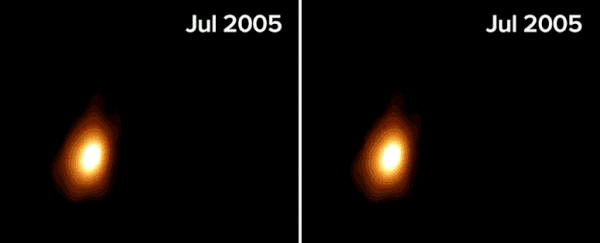When a black hole tears apart a star, not all of it ends up sucked into oblivion. Some of the material gets to be blasted out in a spectacular jet - and now, for the first time, we have direct images of one of those jets forming and expanding.
The event took place in a pair of colliding galaxies called Arp 299, which is nearly 150 million light-years away, each of which has a supermassive black hole at its core.
Using both radio and infrared telescopes, astronomers watched as a star around twice the mass of the Sun drifted too close to one of the supermassive black holes, which has over 20 million times the mass of the Sun.
The poor star never had a chance - the black hole's gravitational force tore it to shreds, an extraordinary process known as a tidal disruption event. These have only been detected infrequently - and never like this.
"Never before have we been able to directly observe the formation and evolution of a jet from one of these events," said astronomer Miguel Perez-Torres of the Astrophysical Institute of Andalusia in Granada, Spain.
Most of the time, black holes are quiescent, hanging around in space doing nothing. Something has to enter their gravitational field in order for them to become active.
Once it does, though, it's a spectacular event. The star is pulled apart, forming an accretion disc around the equator of the black hole. This stuff ends up actually falling into the black hole, and the intense gravitational and frictional forces heat it and cause it to glow.
But not all of this material goes beyond the event horizon. Some of it flows from the inner part of the accretion disc via magnetic field lines to the black hole's poles, where radiation and particles are blasted into space at near light-speed, forming the characteristic jets.
Observations of this particular event, dubbed Arp 299-B AT1, actually began all the way back in 2005. On January 30, the William Herschel Telescope in the Canary Islands captured a burst of infrared emission from the heart of one of the Arp 299 galaxies.
And then on July 17, National Science Foundation's Very Long Baseline Array caught another one.
Here's the kicker, though: telescopes operating in visible light couldn't see it - implying that Arp 299 is thick with dust, blocking visible light.
"As time passed, the new object stayed bright at infrared and radio wavelengths, but not in visible light and X-rays," said astronomer Seppo Mattila of the University of Turku in Finland.
"The most likely explanation is that thick interstellar gas and dust near the galaxy's center absorbed the X-rays and visible light, then re-radiated it as infrared."
Over the course of nearly a decade, astronomers observed the object using both infrared telescopes and radio telescopes. And they saw an emission moving outwards at high speed, in one direction - just as would be expected from a relativistic jet.
Scientists have long hypothesised that tidal disruption events may be occurring much more frequently than we know. There's a supermassive black hole at the heart of most galaxies - many more could be obscured by dust, much like Arp 299, and even Sagittarius A*, the supermassive black hole at the core of the Milky Way.
Arp 299-B AT1 provides an opportunity to learn about how relativistic jets are formed, as well as how supermassive black holes grow to their enormous dimensions. But it also provides clues that may lead us to more tidal disruption events.
"Because of the dust that absorbed any visible light, this particular tidal disruption event may be just the tip of the iceberg of what until now has been a hidden population," Mattila said.
"By looking for these events with infrared and radio telescopes, we may be able to discover many more, and learn from them."
The research has been published in the journal Science.
